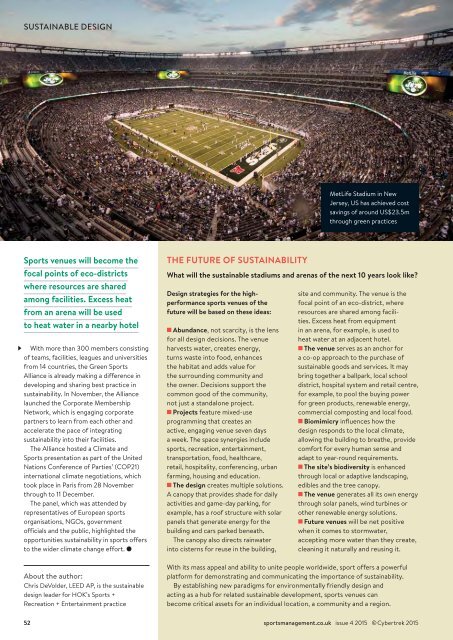EDDIE IZZARD
SM_issue4_2015
SM_issue4_2015
Create successful ePaper yourself
Turn your PDF publications into a flip-book with our unique Google optimized e-Paper software.
SUSTAINABLE DESIGN<br />
MetLife Stadium in New<br />
Jersey, US has achieved cost<br />
savings of around US$23.5m<br />
through green practices<br />
Sports venues will become the<br />
focal points of eco-districts<br />
where resources are shared<br />
among facilities. Excess heat<br />
from an arena will be used<br />
to heat water in a nearby hotel<br />
With more than 300 members consisting<br />
of teams, facilities, leagues and universities<br />
from 14 countries, the Green Sports<br />
Alliance is already making a difference in<br />
developing and sharing best practice in<br />
sustainability. In November, the Alliance<br />
launched the Corporate Membership<br />
Network, which is engaging corporate<br />
partners to learn from each other and<br />
accelerate the pace of integrating<br />
sustainability into their facilities.<br />
The Alliance hosted a Climate and<br />
Sports presentation as part of the United<br />
Nations Conference of Parties’ (COP21)<br />
international climate negotiations, which<br />
took place in Paris from 28 November<br />
through to 11 December.<br />
The panel, which was attended by<br />
representatives of European sports<br />
organisations, NGOs, government<br />
officials and the public, highlighted the<br />
opportunities sustainability in sports offers<br />
to the wider climate change effort. <br />
About the author:<br />
Chris DeVolder, LEED AP, is the sustainable<br />
design leader for HOK’s Sports +<br />
Recreation + Entertainment practice<br />
THE FUTURE OF SUSTAINABILITY<br />
What will the sustainable stadiums and arenas of the next 10 years look like?<br />
Design strategies for the highperformance<br />
sports venues of the<br />
future will be based on these ideas:<br />
Abundance, not scarcity, is the lens<br />
for all design decisions. The venue<br />
harvests water, creates energy,<br />
turns waste into food, enhances<br />
the habitat and adds value for<br />
the surrounding community and<br />
the owner. Decisions support the<br />
common good of the community,<br />
not just a standalone project.<br />
Projects feature mixed-use<br />
programming that creates an<br />
active, engaging venue seven days<br />
a week. The space synergies include<br />
sports, recreation, entertainment,<br />
transportation, food, healthcare,<br />
retail, hospitality, conferencing, urban<br />
farming, housing and education.<br />
The design creates multiple solutions.<br />
A canopy that provides shade for daily<br />
activities and game-day parking, for<br />
example, has a roof structure with solar<br />
panels that generate energy for the<br />
building and cars parked beneath.<br />
The canopy also directs rainwater<br />
into cisterns for reuse in the building,<br />
site and community. The venue is the<br />
focal point of an eco-district, where<br />
resources are shared among facilities.<br />
Excess heat from equipment<br />
in an arena, for example, is used to<br />
heat water at an adjacent hotel.<br />
The venue serves as an anchor for<br />
a co-op approach to the purchase of<br />
sustainable goods and services. It may<br />
bring together a ballpark, local school<br />
district, hospital system and retail centre,<br />
for example, to pool the buying power<br />
for green products, renewable energy,<br />
commercial composting and local food.<br />
Biomimicry influences how the<br />
design responds to the local climate,<br />
allowing the building to breathe, provide<br />
comfort for every human sense and<br />
adapt to year-round requirements.<br />
The site’s biodiversity is enhanced<br />
through local or adaptive landscaping,<br />
edibles and the tree canopy.<br />
The venue generates all its own energy<br />
through solar panels, wind turbines or<br />
other renewable energy solutions.<br />
Future venues will be net positive<br />
when it comes to stormwater,<br />
accepting more water than they create,<br />
cleaning it naturally and reusing it.<br />
With its mass appeal and ability to unite people worldwide, sport offers a powerful<br />
platform for demonstrating and communicating the importance of sustainability.<br />
By establishing new paradigms for environmentally friendly design and<br />
acting as a hub for related sustainable development, sports venues can<br />
become critical assets for an individual location, a community and a region.<br />
52 sportsmanagement.co.uk issue 4 2015 © Cybertrek 2015


